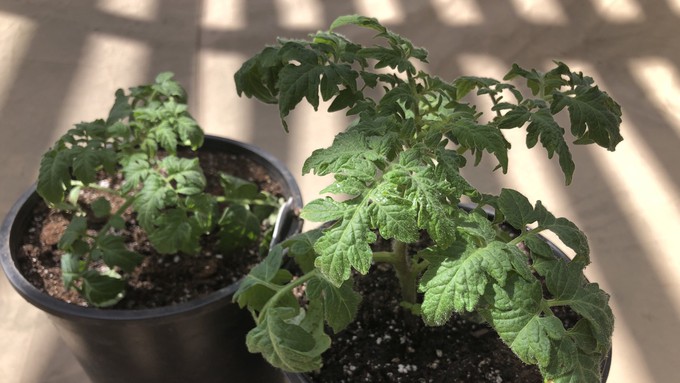
Take care of the plants (and soil) until the weather cooperates

These two plants were recently transplanted to 1-gallon pots from 4-inch containers. They're big enough to spend a few hours outdoors on a partly covered patio. Kathy Morrison
The sun is out! That’s good news. The bad news, of course, is that thanks to the recent rainstorms the soil is soggier than a sloppy sponge. And the overnight temperatures are stuck in the 30s and low 40s at least until Easter.
None of this is good for putting in young tomato plants. Tomato roots need warm loamy soil with air pockets, not mud. Ideal overnight temps should be 50 degrees. At best any plants outside will just sit there; at worst, they could be killed by cold.
Yet gardeners around here are itching to PLANT. All the nurseries are full of beautiful tomato plants. And those of us who regularly start seeds have baby plants of various sizes in greenhouses or under grow lights or in kitchen windows – and we are running out of room for them.
What to do until planting conditions are better?
– Make sure the tomato plants have enough room for their roots. Repot 6-pack-size plants to something tall like a large Starbucks plastic cup or a 24-ounce yogurt container. (Punch holes in it!) Move a 4-inch nursery plant to a 1-gallon pot. Larger plants in 1-gallon pots can move up to 2-gallon containers. (Try a cloth grow pot so it’s not too heavy to move.) A plant that has become leggy should be planted deep, up to its first set of leaves, so that new roots have the chance to grow along the buried stem.
– Give the plants enough light and warmth. If daytime temps creep up to 60, bring the plants outside for some sunshine. But be careful: Putting tender plants in direct sun could bleach the leaves, so some filtered sun is better until they’re a little hardier. Eventually they can stay out all day. I set up a temporary “greenhouse” (stacked shelves and a zipped plastic cover) at this point on a back porch so I can move the plants undercover in the evening and avoid dragging them back into the house. I also can run old Christmas lights in there if I think they need it.
– If your tomatoes are already in the ground, and have survived all the rain, wind and cold so far, congrats and go buy some lottery tickets – it’s your year! We’re not out of the woods, yet, though, so watch the weather forecasts closely thIs next week – Tuesday morning (April 4) could be frosty, for example. I know some people swear by commercial plant protection devices like the Wall O Water but I’ve never tried them. Improvised devices can include milk jugs with the bottom cut off, assuming the plants are that small, or row covers.
– If you haven’t done so yet, use some of that pent-up planting energy to prep your garden, rather than do it right before planting next month or in early May. After the soil dries somewhat, work in some poultry manure or whatever organic/natural product you prefer. (Worm castings are great if you have access to them.) Or just scatter the product on top if things are too wet. Soil health should be your primary concern. Artificial fertilizers do help plants grow but do nothing for the soil.
-- Also, this bears repeating: Don't walk on wet soil! At least where you intend to plant anything. Compacted soil loses its natural air pockets, and the essential organisms in the soil could be squeezed out.
-- Now, patience! We'll all have our tomatoes eventually.
For more on growing tomatoes and other vegetables, visit the Sacramento County master gardeners’ site for UC garden notes and other guides. I also like this 2017 post on tomato growing from the Farmer Fred Rant: https://farmerfredrant.blogspot.com/2017/03/tips-for-great-tomato-garden.html
Comments
0 comments have been posted.Sacramento Digs Gardening to your inbox.
Sites We Like
Garden Checklist for week of July 21
Your garden needs you!
* Keep your vegetable garden watered, mulched and weeded. Water before 8 a.m. to reduce the chance of fungal infection and to conserve moisture.
* Feed vegetable plants bone meal, rock phosphate or other fertilizers high in phosphate to stimulate more blooms and fruiting. (But wait until daily high temperatures drop out of the 100s.)
* Don’t let tomatoes wilt or dry out completely. Give tomatoes a deep watering two to three times a week.
* Harvest vegetables promptly to encourage plants to produce more. Squash especially tends to grow rapidly in hot weather. Keep an eye on zucchini.
* Pinch back chrysanthemums for bushy plants and more flowers in September.
* Remove spent flowers from roses, daylilies and other bloomers as they finish flowering.
* Pinch off blooms from basil so the plant will grow more leaves.
* Cut back lavender after flowering to promote a second bloom.
* It's not too late to add a splash of color. Plant petunias, snapdragons, zinnias and marigolds.
* From seed, plant corn, pumpkins, radishes, winter squash and sunflowers.